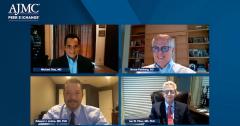
Requirements for CAR T in a Community Setting
Episodes in this series

Criteria for setting up the infrastructure and logistics for CAR T administration in a sophisticated community center.
Transcript
Bruce Feinberg, DO: We have a lot of barriers, and when the original discussion came about, the whole concept of outpatient CAR [chimeric antigen receptor] T therapy, there was a human cry. It will be like IL-2: We tried this before; it doesn’t work; fewer centers, not more. We need high-volume centers that understand these patients, teams that are really experienced in managing the toxicity. Ian, back to you because you’re doing this work. With that, it has to be FACT [Foundation for the Accreditation of Cellular Therapy] accredited, but there aren’t enough FACT-accredited sites. The last check I saw, there were over 100 FACT-accredited sites doing CAR T. Not all were doing both agents currently available for lymphoma. But it does raise that question of here’s the 1 side that uses the reason of quality of why it should be more restricted. Then there’s the side that talks about all these barriers, and the access problems, and the care coordination problems, and the other issues to say that we’re not optimizing this therapy for the patients in need. Where do you think it falls? Even though you’re in a tertiary center environment, what do you think would be, what are those kinds of criteria? Maybe it’s not FACT. Maybe it’s something else. Do they have to do acute leukemia management? Is it a matter of volume and experience of the team? How does that team get that experience? Based on what you’ve already learned, what do you think are some of the criteria that should be looked at?
Ian W. Flinn, MD, PhD:We are a tertiary care facility, but we are in a community. I’m not at a university. I’m at a private practice in the community, and we had to develop a lot of these systems over the years. Your point is very well taken that if someone can’t get the care, if there are barriers of care, then we’re not going to improve survival for the totality of patients with the disease. If you look at the National Marrow Donor Program, they have estimated that the number that need allogeneic transplants for leukemia-related disorders is a fraction of the people who should get it. There are also those barriers that are going on to prevent them from having that, and that’s because they can’t get to the center that does it. There are all the barriers that we just talked about. If we’re going to be effective in CAR T cells, we’re going to have to bring down some of these barriers.
There’s a requisite set of propagations that centers need to do this. I look at them in 3 different buckets. One is administrative, 1 is acquisition of the CAR T cells, and the third is the clinical know-how to do it. Administration is obvious. You need people knowledgeable in contracting and acquiring the cellular therapy, working with the companies. The acquisition of the T cells from the patient is a different subject. In our center, we have our own collection facility, but you could imagine outsourcing that to the Red Cross or some other facility where you could do it. But you’d want to have a quality program where the patient could undergo a leukapheresis and have the product shipped to the facility.
Finally, there’s the clinical know-how. When we did our first CAR T cell, there was so much hype about it, and you were worried that the patient was going to explode in front of you. But you learned that it’s just another therapy, just as you do all the time. There’s a learning curve. Centers need to partner with places that have done this before. They need to dedicate several doctors who are going to do this for them. It can’t be every doctor in a practice, but focus on a few. Then they need to train up the facility, where they’re going to end up with a patient if things don’t do well.
If they do it outpatient and someone suddenly develops cytokine release syndrome or they develop neurotoxicity, they have to have a willing partner in a hospital that’s willing to dedicate the resources, have an emergency department that knows what a CAR T cell is, have an ICU [intensive care unit] doctor who understands cytokine release syndrome, have a group of hospitals that are also willing to work with you and develop all the SOPs [standard operating procedures]. There’s a requisite number of steps, but it’s not all that different from other complex care that has been developed in the community setting. Think about it: Cardiac surgery never occurred anyplace but the university hospital. Now it’s an everyday occurrence out in the community. This can be accomplished.
Newsletter
Stay ahead of policy, cost, and value—subscribe to AJMC for expert insights at the intersection of clinical care and health economics.


























































